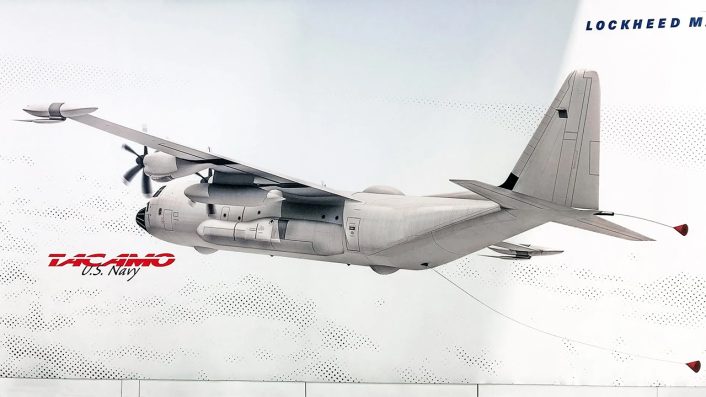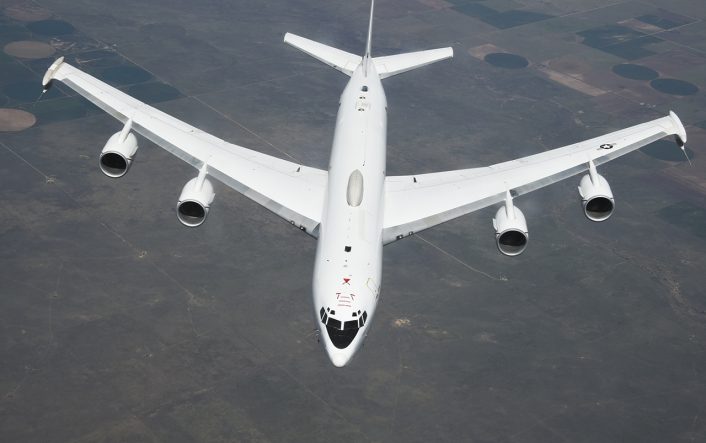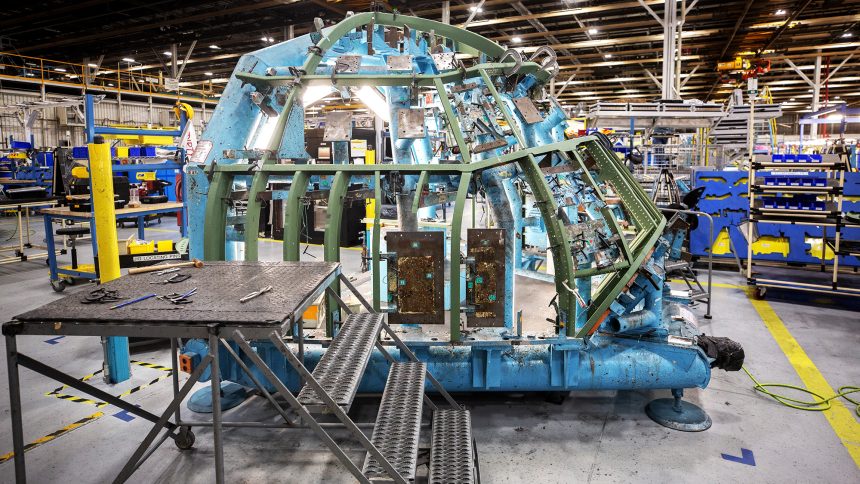The first C-130J-30 Hercules earmarked for conversion into an E-130J TACAMO aircraft for the U.S. Navy is in production.
Fresh on the heels of the announcement that the U.S. Navy’s E-6B Mercury replacement in the take charge and move out (TACAMO) role will be designated E-130J, it has been revealed that the first C-130J-30 airframe that will undergo conversion to E-130J standard is in production at Lockheed Martin’s Marietta, Georgia facility.
The C-130J-30 airframe was chosen for this role in 2020, and the program began to be known as E-XX. Lockheed Martin is currently scheduled to deliver the first complete airframe in FY 2026, after which it will be converted into an E-130J Engineering Development Model.
The contract for integrating TACAMO mission systems into the airframe is due to be awarded by the U.S. Navy’s Airborne Strategic Command, Control and Communications Program Office (PMA-271) in January 2025.
While the airframe will be smaller than the Boeing 707-300 based E-6B it will replace, the use of the extended C-130J-30 airframe will mean a significant boost in performance and capacity compared to the original EC-130Q TACAMO aircraft operated between 1963 and 1993.
This smaller airframe is countered by newer, more compact technologies as well as a reduction in crew requirements with the elimination of the U.S. Air Force Airborne National Command Post (ABNCP) mission from the aircraft. Official U.S. Navy documentation lists the E-6B’s crew size as 22 personnel, but this includes the 8 person battlestaff who are dedicated to the ABNCP ‘Looking Glass’ mission. An E-130J crew therefore could be reduced to 14 personnel or perhaps even fewer.
Similar to the E-6B, the E-130J will carry two trailing wire antennas and a series of other communications capabilities, including satellite communications (SATCOM). The trailing wire antenna system is one of the more fascinating systems in the TACAMO mission, with the longest wire reaching 28,500ft in length and the shorter wire approximately 5,000ft.

The antenna wires are deployed while the aircraft enters a series of tight spiral turns over water, causing them to droop vertically using weighted drogues towards the ocean surface. The exact length of antenna deployed is variable depending on frequency in use – the crew can consult a chart in the E-6B’s Naval Air Training and Operating Procedures Standardization (NATOPS) manual for exact lengths required for different frequencies in the VLF range. Frequencies used are between 17kHz and 60kHz.
The long wire acts as a counterpoise element, passively boosting the transmission signal, while the short wire carries the powered transmission. Together they are referred to as the Dual Trailing Wire Assembly (DTWA). If required the aircraft can also transmit VLF communications in level flight, but the propagation is reduced compared to the orbit pattern. The VLF transmissions are ‘in the clear’ and can be decoded using simple software, but the actual contents of the message are only readable by those with the correct codebook or one-time pad, depending on the level of cypher used.
Aerial refueling can keep the E-6B Mercury airborne for up to 72 hours. The E-130J will also be equipped with this capability, although the total time the aircraft is able to remain airborne could change with the new airframe. Non-replenishable goods like food supplies as well as engine oil and other engineering lubricants are the limiting factor.
With the retirement of the E-8C JSTARS in 2023 and the upcoming replacement of the E-3 Sentry with the E-7A Wedgetail the maintenance of Boeing 707 based platforms like the E-6 is quickly becoming economically prohibitive. When they rolled off the production line in the late 1980s and early 1990s the then E-6A Hermes frames were among the final Boeing 707s produced, alongside E-3s for the Royal Air Force and French Air Force. It should be noted that, although similar and derived from the same Boeing 367-80, the C-135 airframe used for the KC-135, RC-135 and WC-135 is very distinct from the Boeing 707 and has limited parts commonality with the latter.
If all goes to plan, the E-130J will begin operations from FY 2028. The E-6B Mercury is expected to remain in service into the early 2030s to ensure a seamless transition. We will likely see a progressive retirement of E-6 airframes as more E-130Js are delivered.

We still do not know with certainty how many E-130Js the Navy intends to eventually acquire. The E-6B Mercury fleet currently numbers sixteen aircraft. An additional airframe, formerly E-3D Sentry AEW1 ZH104 of the Royal Air Force, was purchased and is being converted into a dedicated E-6B pilot training aircraft, although the expected early 2024 first flight date for this aircraft has long slipped by.
Transformers: E-6 in disguise — The process has begun to turn this E-3D into an E-6B in-flight trainer. The outer mold line will be modified to resemble an E-6 and the aerial refueling probe and radar dome will be removed. pic.twitter.com/oQaRAhxspr
— NAVAIR (@NAVAIRNews) October 4, 2022
The removal of the U.S. Air Force Looking Glass mission from the E-130J’s mission set will ease its operational burden compared to the E-6B, which has fulfilled the role since the retirement of the U.S. Air Force’s EC-135 aircraft in 1998. This role includes the Airborne Launch Control System capability, which allows the remote launch of U.S. Air Force intercontinental ballistic missiles by mission crews inside the aircraft. The capability has been demonstrated by the E-6B Mercury on several occasions, but will now need to find a new home.
Most likely, the U.S. Air Force will merge the Looking Glass mission profile into the E-4C Survivable Airborne Operations Centre, the Boeing 747-8 based replacement for the fifty year old E-4B Nightwatch. Like the E-130J, the final quantity of E-4Cs to be purchased is unknown, but some reports suggest the U.S. Air Force intends to operate as many as 8-10 airframes. This would cover the additional operational demands that would be placed on the aircraft if pressed into the Looking Glass role. There are only four E-4B Nightwatch airframes, and at certain times at least half of these have been unavailable. When the President and the U.S. Secretary of Defense both use an E-4B to support their busy overseas travel schedules, this small handful of airframes is already cutting it fine for availability even without the Looking Glass mission.
Speculating on the Future of TACAMO
It will be interesting to see whether a TACAMO fleet unburdened by the Looking Glass role may more frequently forward deploy and operate from overseas locations, due to the reduced need for airframes to be on alert for operations over the continental United States. Forward deployed TACAMO aircraft, with their unique submarine communications capabilities, would then be able to more flexibly support submerged submarine operations across the globe. Current overseas deployments of E-6B aircraft often only number several days, tying into pre-arranged exercises with strategic bombers and ballistic missile submarines.
Sending a message… rare for SSBN to surface while on operations.
🇺🇸 USS Normandy and ballistic missile submarine, USS Tennessee overflown by P-8A Poseidon and E-6B Mercury for PHOTEX in the Norwegian Sea 23/6/24. pic.twitter.com/RwmOszLSHO
— Navy Lookout (@NavyLookout) June 27, 2024
While the primary focus for TACAMO is the nuclear missile equipped ballistic missile submarine fleet, the principle of VLF submarine communication works just as well with conventionally armed attack submarines like the Los Angeles and Virginia classes.
Increased submarine cooperation with the United Kingdom and Australia through the AUKUS agreement will see a higher tempo of submarine detachments to distant locations. From 2027, the U.S. Navy plan to maintain a permanent presence of at least four Virginia class submarines at HMAS Stirling alongside a Royal Navy Astute class submarine. This force will be termed Submarine Rotational Force-West (SRF-West). Forward deployed E-130Js could be used to support the operations of these submarines, as well as perhaps the submarines of the Royal Navy and Royal Australian Navy.
As communications hubs with five HF radio sets, V/UHF ATC radio, UHF orderwire, and EHF SATCOM capabilities, the E-130J could also take after its E-6B predecessor and see use deployed as a command and control support aircraft for conventional military operations.
In 2011, an E-6B Mercury deployed to RAF Mildenhall in the United Kingdom flew an extended sortie which coincided with the launch of Operation Neptune Spear, the operation to capture or kill Osama bin Laden. The E-6B was in contact through the night with B-2A Spirit stealth bombers on a transatlantic sortie, presumably acting as a contingency package in case the ground operation in Pakistan failed.
This 2011 mission was in fact not the first time it had been deployed in the role. From October 2006, a detachment was set up for U.S. Central Command keeping at least one E-6B in the CENTCOM region at all times for missions supporting Operation Iraqi Freedom. Initially intended to last a year, this detachment did not wrap up until April 2009. The detached E-6B unit flew sorties six days a week, spent over 8,000 hours in the air, coordinated 26 medical evacuations, and relayed information on 335 improvised explosive device incidents.
The mission of supporting ballistic missile submarine operations, though, will of course take primacy. While merging technologies have revolutionized many areas of the armed forces, the simple limitations of radio physics still make this type of aircraft the only practical way to carry out the TACAMO mission. Certainly, it is safer and more practical than a very early attempt to produce a deployable VLF capability where a 2 mile long antenna spool was fitted to the USS Wright (CC-2) and pulled aloft vertically by an unmanned QH-43G Huskie helicopter.
It may indeed simply be the case that the E-130J stays solely dedicated to this mission and this mission alone, with only occasional trips abroad as with the E-6B fleet. We will have to wait until its entry into service to find out for sure how these aircraft will be employed.









